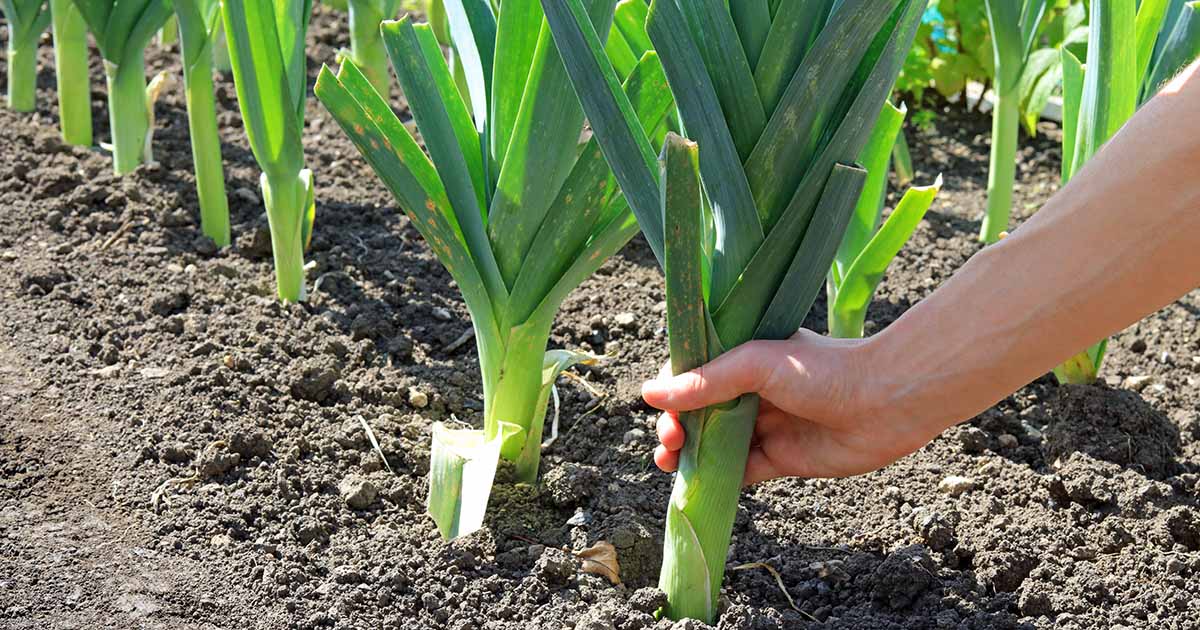Allium ampeloprasum var. porrum
The leek looks like a steroid-fueled green onion. It’s considerably fatter than a scallion, at one to three inches wide, and about twice as tall. But it totally wears the same outfit, albeit in a bigger size.
It is in fact related to onions, offering a mild, sweet, onion-like flavor that is used to season any number of dishes – more on that later in this article.
Leeks are a cool-weather crop, with an ideal growing-temperature range of 55 to 75°F. Like collard greens, they appreciate a frost or two for better flavor development.


We link to vendors to help you find relevant products. If you buy from one of our links, we may earn a commission.
Most varieties are hardy to Zones 7 or 8, though some types can tolerate cooler weather. We’ll offer some specifics shortly.
The plant is a biennial, though damage and dieback due to a hard freeze will make it an annual.
The topmost, leafy green part of the plant is called the “flag,” and the white part is usually called the “stem” or “stalk,” though botanically speaking these are misnomers.
The white part of the plant is technically a tight bundle of leaf sheaths.
Ready to dive in to the fascinating world of the leek? Here’s what’s to come in this article:
It’s time to get growing!
Leeks are native to the eastern Mediterranean and the Middle East. They were cultivated in Egypt more than 4,000 years ago, and enjoyed by the workers who built the pyramids.
As well as being a staple in the diet of ordinary people, apparently the emperor Nero was fond of a leek or two, eating them almost daily to strengthen his voice.
Quick Look
Common name(s): Leek
Plant type: Biennial vegetable
Hardiness (USDA Zone): 5-10
Native to: Mediterranean
Season: Spring
Exposure: Full sun
Soil type: Rich and well draining
Soil pH: 6.0-7, slightly acidic to neutral
Time to maturity: 80-150 days, depends on variety
Spacing: 6 inches
Planting depth: Seeds -1/8 inch, seedlings – half the depth
Mature size: 6-12 inches wide x 2-3 feet high
Water Needs: 1 inch per week
Taxonomy
Order: Apiales
Family: Amaryllidaceae
Genus: Allium
Species: A. ampeloprasum var. porrum
Cultivars: various
The Greek physician Hippocrates is thought to have prescribed this vegetable as a cure for nose bleeds.
Leeks make an appearance in what is regarded as the world’s first cookbook, “Apicius de re Coquinaria,” (“On the Subject of Cooking”) compiled in fourth- to fifth-century Rome.
The recipe collection includes several for leeks, most of which showcase it not as a seasoning for other foods, but as a vegetable to be enjoyed on its own.


It is thought that the vegetable spread across Europe and to the British Isles by the marauding Romans. European settlers brought the vegetable to North America.
For reasons that are not completely understood, the vegetable is today the national emblem of Wales and is worn proudly on St. David’s Day – a holiday to honor the country’s patron saint.
Propagation
You can grow leeks from seed or, like the pineapple, propagate it from kitchen scraps.
From Seed
Start seeds indoors in pots or seed trays. Scatter seeds on top of a rich potting mix, and then cover them with a scant dusting of soil.
You can expect germination within five to 12 days.


Or you can direct sow outdoors, as long as air temperatures are below 77 and above 55°F. The optimal temperature for germination is between 70 and 77°F.
Seedlings will be ready to transplant when they’re six to eight inches tall.
Harden them off by moving them outdoors for a few hours each day, gradually lengthening the time spent outside each day for about a week.
When you’re ready to transplant, remove seedlings from the soil and gently separate them.


Create narrow holes in your prepared bed that are about half as deep as the seedlings, from the root to the top of the stem.
The holes should be narrow, not more than an inch in diameter, and can be made by poking a dowel or ‘dibber’ into the ground – as opposed to digging a hole with a garden spade.
They should be spaced 6 inches apart in rows that are one foot apart.
Set the seedlings into the holes; some of the green part may be below the soil surface, and that’s okay for this plant.
Fill the holes with water, but do not backfill the holes with soil. The soil will gradually crumble in, but it will be loose, allowing the leeks to swell to a plump diameter as they grow.
From Scraps
You can also start a new plant from the rooted bit at the end of a leek stalk.
Simply cut off and use the top, leaving at least an inch of stalk at the end, with the roots intact. Place this bit in a cup, add water to cover about half the stalk, put it in a sunny window, and soon you will have more greens shooting up.
You can also use toothpicks to suspend the cutting in water, as you would with an avocado pit.
Once the top part has started to show new growth of two to three inches, you can plant it out in the garden. Alternatively, keep it in the water to continue growing and harvest straight from your windowsill!
How to Grow
Leeks prefer rich, well-draining soil with a pH between 6.0 and 7.0. They need a minimum of eight hours of bright sunlight daily.
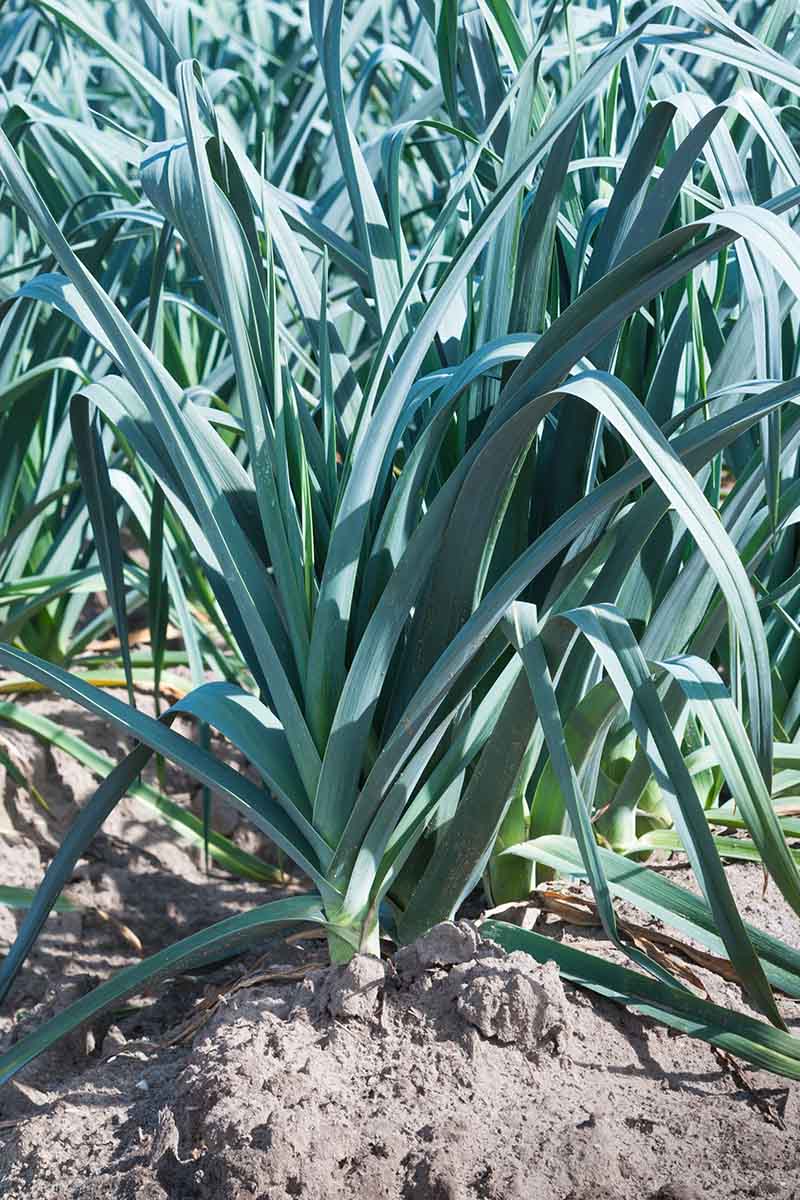

Many varieties require a long growing period of 120 to 150 days, but newer cultivars may require as few as 90 days to mature.
With a shallow root system, leeks need about an inch of water per week, so track your local precipitation rates and irrigate if it doesn’t rain.
Mulch the growing area well.
The white part of the leek is the most desirable for cooking and eating, being tender and less fibrous than the green. Therefore, gardeners often hill the dirt around the shaft to prevent that part of the plant from making chlorophyll and turning green.
Alternatively, you can fashion a sheath out of cardboard or other porous material to wrap around the stalk as it grows. It needs to be opaque but still allow for some airflow, otherwise the leek may start to rot.
About midway through the growing season, side dress the growing area about six inches away from the plants with a balanced fertilizer such as a 10-10-10 NPK mix at a rate of one cup for 10 feet of row.
Leeks are highly tolerant of cold. Depending on the variety, they can take temperatures down to 5°F or so, and a frost or two is said to improve their flavor.
But you definitely want to pull them before the ground freezes.


If you live in a place where you can overwinter leeks, consider that they will probably bolt in spring if they’ve been exposed to frosts and then the weather warms up.
If it’s their second year of life, they’ll bolt regardless, being biennial.
So pull them before the weather gets too warm, or let a few bolt for seed saving purposes. The round purple, lavender, or pink flowers are quite attractive, and after they go to seed, you can harvest and save the seeds for planting next year.
To do this, pluck the pods when they start to crack open. Place them in paper bags to dry, then shake the bags to separate the seeds from the chaff.
If you store the seeds in a cool, dry place, they should remain viable for up to three years.
You can eat the leeks after they bolt, but they’re not very good.
Cultivars to Select
As referenced throughout this article, a number of leek cultivars are available, all with various enticing qualities.
American Flag
This heirloom variety is hardy and will overwinter in mild climates. ‘American Flag’ grows to 20 inches tall and 1.5-2 inches thick. It has thick, blue-green leaves.
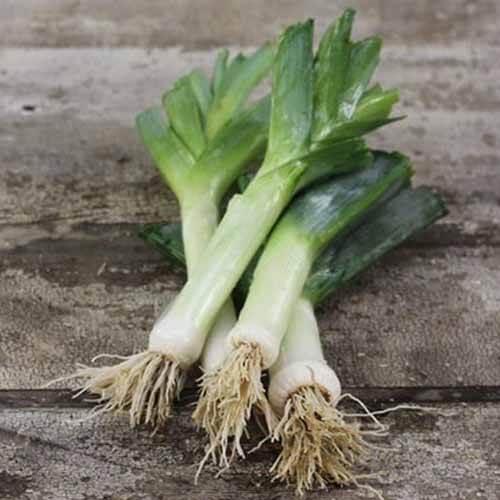

‘American Flag’
‘American Flag’ matures in 130 days. Find seeds in a variety of quantities from Eden Brothers.
Early Giant
Good for planting in early spring, ‘Early Giant’ has a shorter maturation period of 98 days. This heirloom variety is known for its consistent size and great flavor.
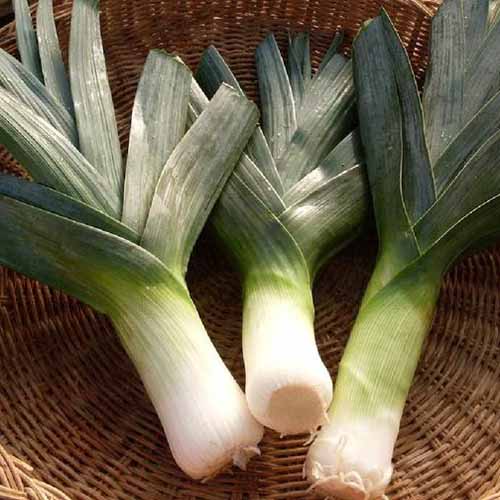

‘Early Giant’
Eden Brothers sells a number of quantities of seeds of this variety.
Autumn Giant Leek
This tall heirloom grows as tall as 30 inches, with stalks that can reach three inches wide at maturity. ‘Autumn Giant’ is ready to harvest in 135 to 150 days.


‘Autumn Giant’
Get packages of about 50 seeds from Frozen Seed Capsules via Amazon.
Lancelot
This adaptable hybrid grows a 12- to 14-inch white shafts with dark blue-green flags. ‘Lancelot’ grows well in many zones, and matures in 75 days.
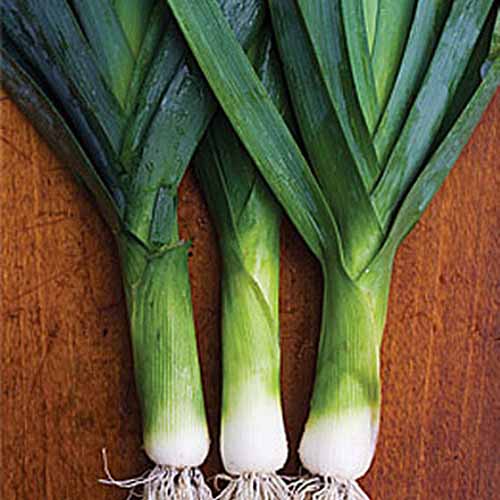

‘Lancelot’
Packages of 72 seedlings of this cultivar are available from Burpee.
Pests and Disease
Leeks, unfortunately, are impacted by a few insects and several types of fungi.
Insects
Keep an eye out for these insect pests:
Leafminers (Lyriomyza spp.)
These tiny, 1/8-inch flies are generally yellow, dark gray, or black, or a combination thereof. They leave thin, white, winding trails on leaves. You might also see white blotches on leaves.


The fly lays its eggs in the leaf, and the larvae feed on the leaf’s interior.
Use neem oil to get rid of these pests.
Find more tips on leafminer control here.
Onion Maggots (Delia antiqua)
The tiny white larvae of this quarter-inch gray fly emerge from eggs laid on leek leaves or in the soil, and then bore into the plant. They grow to about half an inch long, using their feeding hooks to tear up the plant.
This is damaging in and of itself, and the damaged plants are also more susceptible to other pathogens, such as bacteria.


Leaves of affected plants turn yellow and the stalk rots.
Prevention – such as through crop rotation – is the best way to prevent an infestation.
One a plant is impacted, it must be dug up and destroyed.
Thrips (Thrips tabaci)
Yellow or black dots on plants may be a symptom of thrips. Another sign is leaves that turn silver or gray, or leaves that twist and die.
Thrips are small winged insects that damage plants by sucking fluids out. Control them with insecticidal soap, neem oil, or spinosa, a biological pesticide.
Read more about thrip identification and control here.
Disease
Leeks may be plagued by a number of types of fungi, all of which can be treated with a commercial fungicide.


Good airflow and proper planting techniques and watering practices, as well as diligently ridding the beds of errant weeds, can help to protect your plants.
Here are the primary culprits:
Rust (Phragmidium spp.)
Rust is a fungal disease that presents as orange pustules on leaves.
Botrytis Leaf Blight (Botrytis squamosa)
This fungus is characterized by small white lesions ringed in light green.
Damping Off (Fusarium spp.)
Seedlings that grow slowly and then wilt and die may be a sign of damping off. Root tips of affected plants may be tan, yellow, black, or pink. Learn more about this disease here.
Downy Mildew (Peronospora parasitica)
Purplish-gray fuzzy growth on leaf surfaces may be a sign of downy mildew. You may see pale spots on leaves, followed by widespread leaf yellowing and collapsed leaf tips.
Pink Root (Phoma terrestris)
Stunted plants with undersized shafts may be a sign of pink root, which also causes roots to turn light pink and then darken to purple. The roots may be transparent and water-soaked.
Purple Blotch (Alternaria porri)
Purple blotch presents on the flag or stalk with small, water-soaked lesions with white centers. These blotches enlarge and become brown or purple, with yellow edges. Foliage may die.
White Rot (Sclerotinia cepivorum)
White rot can stunt growth, causing yellowing of leaves, and eventual death of all foliage. You may see a fluffy white growth at the base of the plant.
Harvesting
Most leek varieties are fully developed when the stems grow to be a minimum of one inch in width. Some smaller varieties, however, mature at one-half to three-fourths of an inch in diameter.
Check your seed packets so you know what to look for. A good quality leek should have a firm, white shaft that’s more than three inches long.
Leeks can be harvested whenever they’ve reached their desired size. Leek tops do not die back as the plant matures, unlike with onions and shallots, so you can’t rely on that marker.


Simply twist and – gently – pull leeks to harvest them. Or you can dig around them if the soil is dry, and lift them up. You can trim flags to a more manageable length for storage, if you like.
See our guide to how to harvest leeks for seven expert tips.
Preserving
Store leeks in an airtight plastic bag in the crisper drawer of the refrigerator; they’ll stay fresh for about a week.


In really cold areas, there’s a longer-term storage option:
After harvest, leave the roots attached, but cut the flag back to about an inch. Place stems root-end down in a box and fill it with sand, vermiculite, or sawdust.
Keep the packing moist, but not waterlogged, and store in a cool place, where they will keep for about eight weeks.
You can freeze these veggies too. Wash them thoroughly (more on this shortly), slice them, and blanch for one minute in boiling water.
Blanching helps vegetables to retain their color and nutrients, and it destroys enzymes that can cause spoilage.
Drain the blanched slices, dry them, and place them in zip-top plastic freezer bags for storage. They should keep for three to four months.
It’s Smelling a Bit Strong in Here
Most gardeners who’ve grown leeks consider them to be fairly easy to grow.
As long as you give them nutritious soil, some fertilizer, and sufficient water, they should do well in your garden. You’ll also want to keep an eye out for pests and fungi.


If you’re not terribly familiar with leeks as an ingredient in your cooking, try expanding your kitchen repertoire with this delicious allium. What better way to do that is there than by growing your own?
Are you an experienced leek grower? Please share your wisdom in the comments below.
While we’re exploring the alliums, why not check out a few onion articles? Give these a read next:

